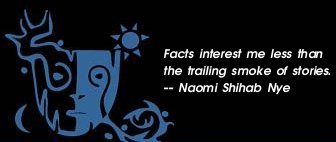|

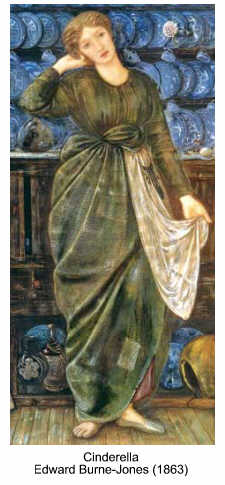 Cinderella:
Ashes, Blood, and the Slipper of Glass
© 1997; updated 2007 by Terri Windling, used by permission
[Images: Edward Burne-Jones, Arthur Rackham, Fredrick Hall, Elenor Abbott, John Batten, Edmund Dulac, Helen Stratton, ]
Once upon a time there was a rich merchant who had a lovely wife and daughter. But the wife died, and in time, the merchant took a second wife. Now this woman was also fair of face, but cruel and hard inside her heart; and she had two wicked daughters whom she favored above all things. She dressed these two in silk and lace and fed them on white cake and cream. Her step-daughter she clothed in rags and fed with scrapings from the bottom of the pot. The child became their scullery girl, and slept in the ashes of the hearth for warmth. She soon grew thin and filthy, and they called her Cinderella....
So begins one of the most famous stories of all time, "Cinderella" (or "Arne-Thompson tale type 510A," as the folklorists note it), a tale which is found in diverse cultures all around the globe. In English-speaking lands, there are few indeed who would not recognize this classic tale. We've all grown up with the wicked step-mother, the cheerless hearth and the slipper of glass; these images have become an indelible part of childhood for us all. Yet the Cinderella we know today is subtly altered from the "Ash Girl" tales handed down for at least a thousand years. Our modern "Cinderella" is a simple (and simple-minded) rags-to-riches story: the tale of a timid, passive girl whose lovely face wins her the "happy ending" of a wealthy marriage. How did the feisty Ash Girl of ages past turn into the feckless creature of the Disney film and countless modern picture books? To examine this, we must go back to the oldest written versions of the story.
 The earliest text we know was recorded in China in the 9th century, although the scribe, Tuan Ch'eng Shih, implies that the story is old even at this time. Yeh-hsien, the Chinese Cinderella, is described as "very intelligent, very clever" and "good at making pottery on the wheel." Her mother dies, and then her father as well, leaving her with the father's co-wife and her daughter, both of whom mistreat Yeh-hsien. Her only friend is a magical golden fish, who appears to her in the pond. The step-mother discovers this source of comfort and promptly kills the fish. Yeh-hsien recovers the bones from the dung heap, and hides them in her room. The bones are magic, and the fish continues to help her even after death, providing the food and drink and warmth that Yeh-hsien's family denies her. When the girl is left behind on festival day, the bones provide her with clothes: a cloak of kingfisher feathers and tiny golden shoes. Running home again, the girl loses a shoe. It is picked up and sold to a warlord, who begins a massive search to find the woman the tiny shoe will fit. (This, remember, is a culture in which tiny feet were then so highly prized that the brutal art of foot binding was practiced on highborn women.) Yeh-hsien reveals herself and becomes chief wife in the warlord's household. The step-mother and step-sister are subsequently stoned to death — but their grave, "The Tomb of the Distressed Women," becomes a local shrine. The earliest text we know was recorded in China in the 9th century, although the scribe, Tuan Ch'eng Shih, implies that the story is old even at this time. Yeh-hsien, the Chinese Cinderella, is described as "very intelligent, very clever" and "good at making pottery on the wheel." Her mother dies, and then her father as well, leaving her with the father's co-wife and her daughter, both of whom mistreat Yeh-hsien. Her only friend is a magical golden fish, who appears to her in the pond. The step-mother discovers this source of comfort and promptly kills the fish. Yeh-hsien recovers the bones from the dung heap, and hides them in her room. The bones are magic, and the fish continues to help her even after death, providing the food and drink and warmth that Yeh-hsien's family denies her. When the girl is left behind on festival day, the bones provide her with clothes: a cloak of kingfisher feathers and tiny golden shoes. Running home again, the girl loses a shoe. It is picked up and sold to a warlord, who begins a massive search to find the woman the tiny shoe will fit. (This, remember, is a culture in which tiny feet were then so highly prized that the brutal art of foot binding was practiced on highborn women.) Yeh-hsien reveals herself and becomes chief wife in the warlord's household. The step-mother and step-sister are subsequently stoned to death — but their grave, "The Tomb of the Distressed Women," becomes a local shrine.
It is not until many centuries later that the tale makes its written appearance in Europe. Giambattista Basile's Italian Cat Cinderella, published in Naples in 1634, is one of the earliest extant western versions of the story. Basile's "La Gatta Cenerentola" tells the tale of a rich widower and his lovely daughter, Zezolla. The widower marries a wicked woman who subsequently mistreats the child. Zezolla complains to her beloved governess, who gives the girl the following advice: "When your father leaves the house, tell your step-mother you would like one of the ragged old dresses she keeps in the big chest. She'll open the chest and say, 'Hold the lid.' While she is rummaging around inside, you must let the lid fall suddenly so that it breaks her neck. When she is dead, beg your father to take me for his wife, and then we shall both be happy." Zezolla carries out these rather startling instructions, and her father marries the governess. At this point, the conniving woman reveals she already has six daughters of her own, and then proves to be even more abusive than Zezolla's first step-mother. The girl is reduced to sleeping in the ashes of the hearth along with the kitchen cat, and finally, losing even her name, becomes the Cat Cinderella.
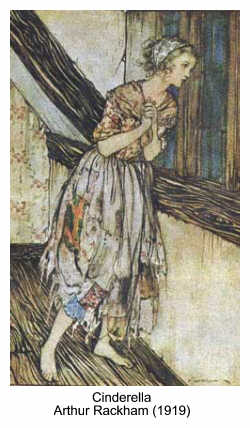 Our heroine is aided by the "fairies of Sardinia," whose favor she gains through her own quick wits. The fairies give her a magic date tree, from which she requests magnificent clothes in order to attend the local feast-day, where she dazzles a neighboring king. On the third feast-day she loses her shoe, and the story continues in a familiar vein — but this Cinderella clearly revels in her cleverness and trickery. It is not a gentle or particularly moral tale, and was never meant for children's ears. Basile recounts "La Gatta Cenerentola" in a prose both earthy and florid, rich with double entendres and filled with the ribald puns so loved by the readers of his day. Our heroine is aided by the "fairies of Sardinia," whose favor she gains through her own quick wits. The fairies give her a magic date tree, from which she requests magnificent clothes in order to attend the local feast-day, where she dazzles a neighboring king. On the third feast-day she loses her shoe, and the story continues in a familiar vein — but this Cinderella clearly revels in her cleverness and trickery. It is not a gentle or particularly moral tale, and was never meant for children's ears. Basile recounts "La Gatta Cenerentola" in a prose both earthy and florid, rich with double entendres and filled with the ribald puns so loved by the readers of his day.
Although the Cat Cinderella is the most complete of the old European Ash Girl stories, Straparola and others published earlier tales which partially resembled "Cinderella" as we know it. None of the surviving variants matches the age of the Chinese story above, leading some scholars to speculate that the original tale (whatever that might be) must have come from the Orient. Wherever the tale began, it certainly succeeded in spreading itself around the world, adapting from culture to culture, from teller to teller, yet keeping its essence intact. In 1883, English folklorist Marian Roalfe Cox published a compilation of three hundred and forty-five variants of Cinderella (and the related tales Catskin and Cap o' Rushes, as well as "Ash Boy" variants), abstracted and tabulated, with a discussion of medieval analogues. In 1951, Swedish folklorist Anna Birgitta Rooth published her Cinderella Cycle; she drew upon over seven hundred versions of the story. The German version, "Aschenputtel," was recorded by the Brothers Grimm in 1812. It begins with the usual death of the mother and the entry of a wicked new wife and her two daughters into the household. The step-child is sent to live in the kitchen, where she is forced to cook and scrub and is subjected to further abuse. The father goes off to a fair and asks each daughter what present she would like. The step-sisters choose clothes and jewels; Ash Girl asks for the first twig that brushes against his hat. She plants this twig on her mother's grave and it grows, from the bones, into a magical tree. The tree can give her whatever she wishes, but Ash Girl waits, and bides her time. There are no talking mice, no pumpkin coaches, no twinkly little fairy godmothers — just a stoic, clever girl in a cruel household, aided by the potent magic of the dead.
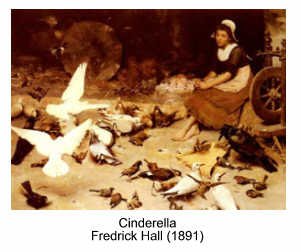 When the King's ball is announced, Ash Girl boldly asks for permission to go. Her step-mother empties a dish of lentils into the hearth, saying, "First you must pick the lentils out of the ashes within two hours. If you succeed, perhaps you'll go to the ball. If you fail, I'll beat you black and blue." The girl calls down the birds from the sky to come to her aid and finish the work. They do so, and the task is fulfilled, but the step-mother will not relent; she tosses two bowls of lentils into the hearth, saying, "Pick them out again within one hour." The birds come again at the Ash Girl's bidding; she fulfils her task, but to no avail. When the King's ball is announced, Ash Girl boldly asks for permission to go. Her step-mother empties a dish of lentils into the hearth, saying, "First you must pick the lentils out of the ashes within two hours. If you succeed, perhaps you'll go to the ball. If you fail, I'll beat you black and blue." The girl calls down the birds from the sky to come to her aid and finish the work. They do so, and the task is fulfilled, but the step-mother will not relent; she tosses two bowls of lentils into the hearth, saying, "Pick them out again within one hour." The birds come again at the Ash Girl's bidding; she fulfils her task, but to no avail.
"You're much too filthy and ragged," the step-mother says as she leaves for the ball. Undaunted, Ash Girl requests a golden dress from the tree on her mother's grave. She goes to the ball and dances with the prince, and yet conceals her identity from him (although there has been no magical injunction compelling her to do so). Twice she slips away from him despite his attempts to follow her home. Her father, oddly, makes an appearance here — he suspects her tricks and tries to catch her out, acting enraged, even violent now. The third night the prince resorts to a trick of his own — he covers the stairs with pitch, and one of her silver slippers sticks fast. The Prince proclaims he will marry whichever girl the tiny slipper fits. The first step-sister cannot fit the shoe, until her mother hacks off her big toe. The prince takes her away as his bride, but as they pass the grave the birds cry out: "Look! Look! There's blood in the shoe! The shoe's too small! The right bride is still at home!" Now the second step-sister tries on the shoe, and it fits — once her mother hacks off her heel. Once again the birds warn the prince he has the wrong girl, and he returns and finds Ash Girl at last. The pair are married — while on the wedding day birds peck out the step-sisters' eyes.
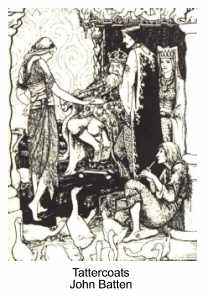 In "Rushen Coatie," a Scottish version of the tale collected one hundred years ago, the dead mother comes back in the form of a cow to feed her starving child — until the suspicious step-sisters discover this and have it killed. The animal's bones retain the potent magic of the dead woman, providing the girl with clothes so that she can go to church and meet her prince (i.e: her ticket, in older societies, to life beyond the family walls). Many versions of the tale throughout the world contain this ghostly element: the bird or cow or cat or hound containing the dead mother's spirit, contrasting the strength of the first mother's love with the second mother's wickedness. Fairy tales, Marina Warner has pointed out in her brilliant study From the Beast to the Blonde, often reflect the particular conditions of the society in which they are told. "The absent mother," she writes, "can be read as literally that: a feature of the family before our modern era, when death in childbirth was the most common cause of female mortality, and surviving orphans would find themselves brought up by their mother's successor.... When a second wife entered the house, she often found herself and her children in competition — often for scarce resources — with the surviving offspring of the earlier marriage. In "Rushen Coatie," a Scottish version of the tale collected one hundred years ago, the dead mother comes back in the form of a cow to feed her starving child — until the suspicious step-sisters discover this and have it killed. The animal's bones retain the potent magic of the dead woman, providing the girl with clothes so that she can go to church and meet her prince (i.e: her ticket, in older societies, to life beyond the family walls). Many versions of the tale throughout the world contain this ghostly element: the bird or cow or cat or hound containing the dead mother's spirit, contrasting the strength of the first mother's love with the second mother's wickedness. Fairy tales, Marina Warner has pointed out in her brilliant study From the Beast to the Blonde, often reflect the particular conditions of the society in which they are told. "The absent mother," she writes, "can be read as literally that: a feature of the family before our modern era, when death in childbirth was the most common cause of female mortality, and surviving orphans would find themselves brought up by their mother's successor.... When a second wife entered the house, she often found herself and her children in competition — often for scarce resources — with the surviving offspring of the earlier marriage.
"This antipathy seethes in the plots of many 'Cinderellas', sometimes offering an overt critique of social custom. Rossini's Cinderella opera, La Cenerentola, shows worldly-wise indignation at his heroine's plight; in her case, at the hands of her stepfather, Don Magnifico, who plots to make himself rich by marrying off his two other daughters, ignoring Cinderella. Tremendous buffoon he might be, but he treacherously pronounces Cinderella dead when he thinks it will help advance his own interests. And when she protests, he threatens her with violence. Dowries are at issue here, as they were in Italy in Rossini's time; sisters compete for the larger share and Don Magnifico does not want to cut his wherewithal three ways. As it was gradually amassed, such corredo (treasure) was stored in cassoni, which were often decorated with pictures of just such stories as 'Cinderella'."
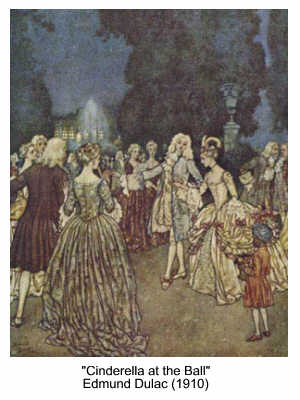 The Rossini opera is unusual in casting a man in the step-parent role. Yet the primary male in other tales — Cinderella's natural father — is an ambiguous figure at best. Angela Carter (in her story "Ashputtle" or "The Mother's Ghost" writes, "The father is a mystery to me. Is he so besotted with his new wife that he cannot see how his daughter is soiled with kitchen refuse and filthy from her ashy bed and always hard at work? If he sensed there was a drama in hand, he was content to leave the entire production to the women for, absent as he might be, always remember that it is his house where Ashputtle sleeps on the cinders, and he is the invisible link that binds both sets of mothers and daughters in their violent equation." The Rossini opera is unusual in casting a man in the step-parent role. Yet the primary male in other tales — Cinderella's natural father — is an ambiguous figure at best. Angela Carter (in her story "Ashputtle" or "The Mother's Ghost" writes, "The father is a mystery to me. Is he so besotted with his new wife that he cannot see how his daughter is soiled with kitchen refuse and filthy from her ashy bed and always hard at work? If he sensed there was a drama in hand, he was content to leave the entire production to the women for, absent as he might be, always remember that it is his house where Ashputtle sleeps on the cinders, and he is the invisible link that binds both sets of mothers and daughters in their violent equation."
This is a women's story, concerned with relationships between women: between Cinderella and her mother on the one hand, the second wife and her daughters on the other. Yet, as Carter is quick to point out, the father is "the unmoved mover, the unseen organizing principle. Without the absent father there would have been no story because there would have been no conflict." In every version of the story I have read, the father casts a remarkably blind eye over the circumstances of his household. He quickly disappears from the story both emotionally and literally. It is not to him that the Ash Girl turns — help must come from another source: from the mother's ghost, or the bones of a fish; from a giant stork in a Javanese version; from a talking doll in a Russian variant; from the king of the frogs in an African "Cinderella" collected in Hausaland; from spiders, eagle-women, and spirits in Native American renditions.
A remarkable version of the story was recorded twenty years ago in eastern Iran in which, like the Scottish version, the mother returns in the form of a cow. The story is part of a Muslim women's rite in honor of Bibi Fatimeh (the daughter of Mohammed and wife of Ali, also known as the Lady of Wishes) in which a ritual meal is prepared in supplication for the fulfillment of a wish. The ingredients for the meal must be begged from certain households in a certain way: the begging is done by dark of night by pairs of completely silent women whose identity remains concealed. The food is taken to the mosque. No men may be present there.
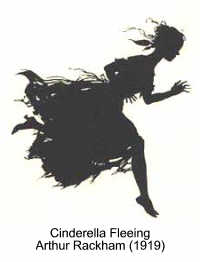 In the morning the women return and a meal is prepared of foods no men may touch: komaj, a bread of "blessed" flour, and ash, a kind of soup. A widow and a motherless virgin sit side by side in the center of the mosque, surrounded by ten to fifty other women. The widow has a bowl of ash. The young girl has an empty bowl. As the widow spoons soup into the child's bowl, she recites "Mah Pishani," a long and lively variant of "Cinderella." Each time the girl receives a spoonful of ash, she must answer "Yes" to affirm the tale, which is briefly thus: A rich merchant sends his daughter to religious school. A female teacher at the school convinces the girl to kill her mother and put her in a vinegar jar, and subsequently the teacher marries the widowed father. The new wife bears a child, after which the first daughter is starved and mistreated. The original wife comes back in the form of a cow and gives aid to the girl, who proves herself to be quick-witted and good-hearted after all. The second daughter is vain and lazy and this eventually causes her downfall. The first is rewarded with a moon on her brow, a star on her chin, and a good marriage. The second is cursed with a snake on her chin and a donkey penis on her forehead. At the end of the story, the meal is consumed and the ceremony completed. In the morning the women return and a meal is prepared of foods no men may touch: komaj, a bread of "blessed" flour, and ash, a kind of soup. A widow and a motherless virgin sit side by side in the center of the mosque, surrounded by ten to fifty other women. The widow has a bowl of ash. The young girl has an empty bowl. As the widow spoons soup into the child's bowl, she recites "Mah Pishani," a long and lively variant of "Cinderella." Each time the girl receives a spoonful of ash, she must answer "Yes" to affirm the tale, which is briefly thus: A rich merchant sends his daughter to religious school. A female teacher at the school convinces the girl to kill her mother and put her in a vinegar jar, and subsequently the teacher marries the widowed father. The new wife bears a child, after which the first daughter is starved and mistreated. The original wife comes back in the form of a cow and gives aid to the girl, who proves herself to be quick-witted and good-hearted after all. The second daughter is vain and lazy and this eventually causes her downfall. The first is rewarded with a moon on her brow, a star on her chin, and a good marriage. The second is cursed with a snake on her chin and a donkey penis on her forehead. At the end of the story, the meal is consumed and the ceremony completed.
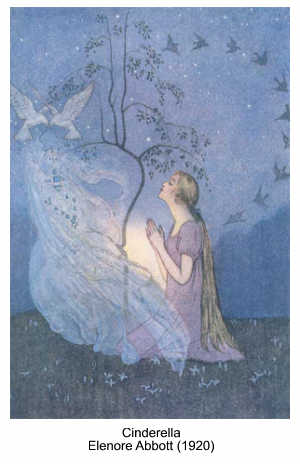 Margaret A. Mils, a folklorist who has worked extensively in Iran and Afghanistan, comments on the tale at the core of this fascinating ritual: "In this form of [Cinderella], as in most, the dominant relationships are between women: loyalty and disloyalty between mother and daughter; rivalry between the stepmother and her offspring and the first born daughter. That the girl first betrays her own mother is an important element in the equation of solidarity and redemption, as is the choice of this story as part of a solidarity ritual for women, in which women join together to call on a spiritual "mother," deceased but present, in support of the desires of one or more of their members .... The marking of the wicked daughter with a donkey's penis and a snake, in contrastive relation to the good daughter's marking with signs of radiant female beauty, the moon and star, constitutes a strong rejection of male symbols ... a direct result of her and her mother's attempted exploitation of other females, human and supernatural, and as an indirect result of her mother's antisocial competition for a male. In this tale about women told exclusively for women, acquisition of male characteristics by a female is a grotesque punishment for disloyalty to women." (For more on this story, see Mils's intriguing essay in Cinderella: A Casebook, edited by Alan Dundes.) Margaret A. Mils, a folklorist who has worked extensively in Iran and Afghanistan, comments on the tale at the core of this fascinating ritual: "In this form of [Cinderella], as in most, the dominant relationships are between women: loyalty and disloyalty between mother and daughter; rivalry between the stepmother and her offspring and the first born daughter. That the girl first betrays her own mother is an important element in the equation of solidarity and redemption, as is the choice of this story as part of a solidarity ritual for women, in which women join together to call on a spiritual "mother," deceased but present, in support of the desires of one or more of their members .... The marking of the wicked daughter with a donkey's penis and a snake, in contrastive relation to the good daughter's marking with signs of radiant female beauty, the moon and star, constitutes a strong rejection of male symbols ... a direct result of her and her mother's attempted exploitation of other females, human and supernatural, and as an indirect result of her mother's antisocial competition for a male. In this tale about women told exclusively for women, acquisition of male characteristics by a female is a grotesque punishment for disloyalty to women." (For more on this story, see Mils's intriguing essay in Cinderella: A Casebook, edited by Alan Dundes.)
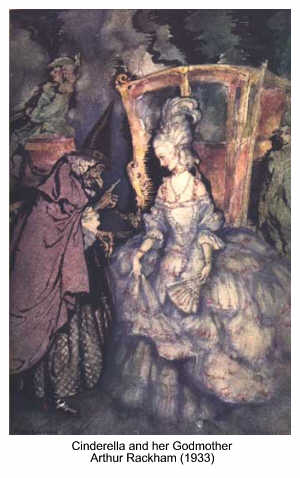 When we turn to the French "Cendrillon," written by Charles Perrault and published in Paris in 1697, we find a version of the story that more closely resembles Cinderella as we know her today. Perrault eliminated the mother's ghost, the lentils in the hearth, the blood-drenched shoe, and added a cheery fairy godmother complete with magic wand. The pumpkin coach and the rat coachmen are original to the Perrault version. (The glass slippers have also been erroneously attributed to Perrault, but they turn up in older, non-French sources as well — which ought to end the debate about whether glass and not fur was simply a mistranslation from the old French.) Perrault's "Cendrillon" is elegant and courtly, written for circulation in aristocratic literary salons. The rough edges of the older tales are smoothed and polished in Perrault's nimble hands. The Ash Girl is more clearly virtuous, and less clearly self-motivated. The sisters are no longer actively sadistic, merely vain, self-centered, and spiteful. In the end, our heroine kindly forgives them, and arranges good marriages for them, too. When we turn to the French "Cendrillon," written by Charles Perrault and published in Paris in 1697, we find a version of the story that more closely resembles Cinderella as we know her today. Perrault eliminated the mother's ghost, the lentils in the hearth, the blood-drenched shoe, and added a cheery fairy godmother complete with magic wand. The pumpkin coach and the rat coachmen are original to the Perrault version. (The glass slippers have also been erroneously attributed to Perrault, but they turn up in older, non-French sources as well — which ought to end the debate about whether glass and not fur was simply a mistranslation from the old French.) Perrault's "Cendrillon" is elegant and courtly, written for circulation in aristocratic literary salons. The rough edges of the older tales are smoothed and polished in Perrault's nimble hands. The Ash Girl is more clearly virtuous, and less clearly self-motivated. The sisters are no longer actively sadistic, merely vain, self-centered, and spiteful. In the end, our heroine kindly forgives them, and arranges good marriages for them, too.
When fairy tales were taken up by the publishers of Victorian children's books, it is not surprising that Perrault's version was the one they most often turned to. Not only was it a kinder, gentler Cinderella, but it was also funny without being bawdy, filled with charming incidents, plump white mice, and long-whiskered rats. It was this version Walt Disney drew upon for his animated film in 1949. This extraordinarily successful film would come to influence the way whole generations now perceive the tale — as well as influencing subsequent printed editions of Cinderella.
 In an incisive essay first published in Children's Literature in Education (#8, 1977), Jane Yolen writes that the Golden Press picture book based on the Walt Disney film In an incisive essay first published in Children's Literature in Education (#8, 1977), Jane Yolen writes that the Golden Press picture book based on the Walt Disney film
"set the new pattern for America's Cinderella. The book's text is coy and condescending. (Sample: 'And her best friends of all were — guess who — the mice!') The illustrations are poor cartoons. And Cinderella herself is a disaster. She cowers as her step-sisters rip her homemade ballgown to shreds. (Not even homemade by Cinderella, but by the mice and birds.) She answers her step-mother with whines and pleadings. She is a sorry excuse for a heroine, pitiable and useless. She cannot perform even a simple action to save herself, though she is warned by her friends, the mice. She does not hear them because she is 'off in a world of dreams.' Cinderella begs, she whimpers, and at last has to be rescued by — guess who — the mice!"
Such editions are responsible for the helpless girl we call by the name Cinderella today; a Cinderella decried by feminists unaware of the Ash Girl's bold ancestry; a Cinderella who, Dr. Yolen points out, "is not recognized by her prince until she is magically back in her ball gown, beribboned, and bejewelled."
As a result, a film like Pretty Woman is promoted with apparent sincerity as a modern day Cinderella tale. What makes Pretty Woman a fairy tale? To an audience weaned on Disney films, it is that a poor but beautiful girl grows up to marry a wealthy "prince." Yet the knight-on-the-white-charger who swoops into our lives and relieves us of the need to determine our own fate is a creature of modern Hollywood films, not of traditional folktales. What has the prostitute heroine of Pretty Woman done to win her prince or transform her life? Precisely nothing — except to be beautiful, and in the right place at the right time.
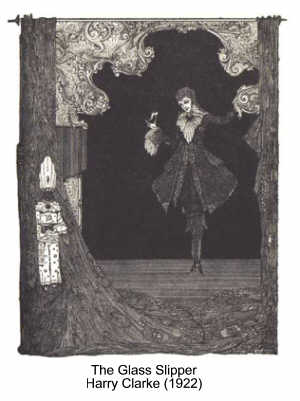 That's no fairy tale. The old tales, as Gertrud Mueller Nelson has succinctly expressed it in her Jungian study, Here All Dwell Free, are about "anguish and darkness." They plunge heroines and heroes into the dark wood, into danger and despair and enchantment and deception, and only then, offer them the tools to save themselves — tools that must be used wisely and well. (Used foolishly, or ruthlessly, they turn back on the wielder.) The power in fairy tales lies in such self-determined acts of transformation. Happy endings, where they exist, are hard won, and at a price. Charlotte Bronte's Jane Eyre is a better example of a fairy tale than Hollywood's Pretty Woman. Combining elements of "Cinderella," "Beauty and the Beast," and other tales, Jane is a classic folklore heroine: good-hearted yes, but also clever, resourceful, and determined. That's no fairy tale. The old tales, as Gertrud Mueller Nelson has succinctly expressed it in her Jungian study, Here All Dwell Free, are about "anguish and darkness." They plunge heroines and heroes into the dark wood, into danger and despair and enchantment and deception, and only then, offer them the tools to save themselves — tools that must be used wisely and well. (Used foolishly, or ruthlessly, they turn back on the wielder.) The power in fairy tales lies in such self-determined acts of transformation. Happy endings, where they exist, are hard won, and at a price. Charlotte Bronte's Jane Eyre is a better example of a fairy tale than Hollywood's Pretty Woman. Combining elements of "Cinderella," "Beauty and the Beast," and other tales, Jane is a classic folklore heroine: good-hearted yes, but also clever, resourceful, and determined.
In modern parlance, the term "fairy tale" is sometimes used to refer to a lie or fanciful untruth. This describes the modern Cinderellas: the Disney film, and Pretty Woman, and umpteen hundred mass market retellings; they lie to us by reducing our dreams to simplistic formulas that empower no one, neither those who wait for Happily Ever After to arrive on the back of a shining white horse, or those who seek it in a pretty face. By contrast, the oldest "Ash Girl" tales use simple language to tell stories that are not really simple at all. They go to the very heart of truth. They've spoken the truth for a thousand years.
Once upon a time, they say, there was a girl ..., there was a boy ..., there was a person who was in trouble. And this is what she did .... and what he did ..., and how they learned to survive it. This is what they did ..., and why one failed ..., and why another triumphed in the end. And I know that it's true, because I danced at their wedding and drank their very best wine.
Further Reading
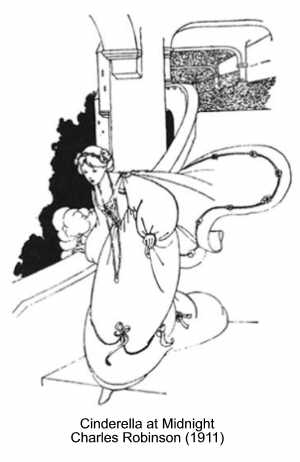
Novels
- The Glass Slipper by Eleanor Farjean
- Just Ella by Margaret Peterson Haddix
- Ella Enchanted by Gail Carson Levine
- Confessions of an Ugly Stepsister by Gregory Maguire
- Bound by Donna Jo Napoli
- Bella at Midnight by Diane Stanley
- The Coachman Rat by David Henry Wilson
Short Stories
- "Glass" by Francesca Lia Block (from The Rose and the Beast)
- "Ashputtle" by Angela Carter (from Burning Your Boats)
- "The Tale of the Shoe" by Emma Donoghue (from Kissing the Witch)
- "Recalling Cinderella" by Karen Joy Fowler (from L. Ron Hubbard Presents the Writers of the Future, 2000)
- "The Prince" by Patricia Galloway (from Truly Grim Tales)
- "Rosie's Dance" by Emma Hardesty (from Black Heart, Ivory Bones)
- "The Ugly Sister" by Joanne Harris (from Jigs and Reels)
- "Switched" by Nina Kiriki Hoffman (from Rotten Relations)
- "The Reason for Not Going to the Ball" by Tanith Lee (from The Year's Best Fantasy & Horror, Vol. 10)
- "When the Clock Strikes" by Tanith Lee (from Red as Blood)
- "Ever After" by Susan Palwick (from The Year's Best Fantasy & Horror, Vol. 1)
- "Ashputtle" by Peter Straub (from Black Thorn, White Rose)
- "Cinder Elephant" by Jane Yolen (from A Wolf at the Door)
Poetry
- Disenchantments: An Anthology of Modern Fairy Tale Poetry, edited by Wolfgang Mieder
- The Poets' Grimm: 20th Century Poems from Grimms Fairy Tales, edited by Jeanne Marie Beaumont and Claudia Carlson
On Fairy Tales
- Cinderella, a Casebook, edited by Alan Dundes
- The Annotated Classic Fairy Tales by Maria Tatar
- From the Beast to the Blonde: On Fairy Tales and Their Tellers by Marina Warner
- Touch Magic: Fantasy, Faerie and Folklore in the Literature of Childhood by Jane Yolen
- The Oxford Companion to Fairy Tales, edited by Jack Zipes
Terri Windling, is a writer, folklorist, and consulting editor for Tor Books. She is best known for her editorial work in the field of fantasy literature, where she has long been a passionate advocate of mythic fiction. She has published over forty books, including The Wood Wife (a mythic novel set in contemporary Tucson, Arizona), The Winter Child (a mythic novel set in contemporary Tucson, Arizona), The Winter Child (a picture book with artist Wendy Froud), the six-volume Snow White, Blood Red series (literary fairy tales for adult readers) and The Armless Maiden (literary fairy tales addressing the subject of child abuse) — as well as short stories, children's fiction, and the annual The Year's Best Fantasy & Horror (a picture book with artist Wendy Froud), the six-volume Snow White, Blood Red series (literary fairy tales for adult readers) and The Armless Maiden (literary fairy tales addressing the subject of child abuse) — as well as short stories, children's fiction, and the annual The Year's Best Fantasy & Horror volumes (with horror editor Ellen Datlow). Her essays on myth, fairy tales, and art have appeared in Realms of Fantasy magazine, and in books including Mirror, Mirror on the Wall: Women Writers Explore Their Favorite Fairy Tales volumes (with horror editor Ellen Datlow). Her essays on myth, fairy tales, and art have appeared in Realms of Fantasy magazine, and in books including Mirror, Mirror on the Wall: Women Writers Explore Their Favorite Fairy Tales (Expanded Edition), and Meditations on Middle-Earth, and Fées. Windling has won six World Fantasy Awards, and the 1997 Mythopoeic Award for Novel of the Year. Also an accomplished artist, Windling creates "folkloric" paintings inspired by myth, fairy tales, and women's history. Her art has been exhibited in galleries and museums in the U.S. and abroad. In 1987, Windling created the Endicott Studio, and in 2001 she co-created Endicott West (an arts retreat in Arizona) with Ellen Kushner and Delia Sherman. She is a founding member of the Interstitial Arts Foundation.. (Expanded Edition), and Meditations on Middle-Earth, and Fées. Windling has won six World Fantasy Awards, and the 1997 Mythopoeic Award for Novel of the Year. Also an accomplished artist, Windling creates "folkloric" paintings inspired by myth, fairy tales, and women's history. Her art has been exhibited in galleries and museums in the U.S. and abroad. In 1987, Windling created the Endicott Studio, and in 2001 she co-created Endicott West (an arts retreat in Arizona) with Ellen Kushner and Delia Sherman. She is a founding member of the Interstitial Arts Foundation..
Return to Mythic Passages Menu
Subscribe to the Mythic Passages e-zine
|
